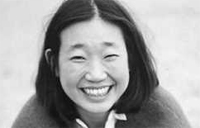On Jan. 14, York’s Canadian Writers in Person course and lecture series presented author Madeleine Thien reading from her novel Dogs at the Perimeter. Special correspondent Chris Cornish (BA Hons. ’04, MA ’09) sent the following report to YFile.
Hiroji knew what it was to have the missing live on, unending, within us. They grow so large, and we so empty, that even the coldest winter nights won’t swallow them.
From Dogs at the Perimeter
by Madeleine Thien

“Why do we turn others’ suffering into art?” This is the question Madeleine Thien often had in her mind as she wrote her second novel. In Dogs at the Perimeter, a neuroscience researcher in Montreal is haunted by childhood memories of the Cambodian genocide after the disappearance of her mentor. Like many survivors of such tragedies, memories can suddenly be triggered and start the cycle of grief all over again. Thien recently shared her experience of writing this story in the Canadian Writers in Person series.
Thien never set out to write a novel about such a large-scale tragedy. She had spent a lot of time visiting Cambodia, and found that its people and its history were increasingly more intriguing. Until recently, most of the stories coming from that time were memoirs and other non-fiction accounts. After trying her hand at some essays, Thien found herself returning to fiction. The emotions and fears could not otherwise be articulated because “no book or language could encompass the genocide, it’s simply impossible.” Instead, she tried to “find a language for one person, through one particular set of circumstances and one particular world-view.”
There are also things you can say in fiction that you can’t say in non-fiction. For instance, Thien was aware that Cambodian refugees would not have been able to escape by boat as her character does. Yet, her story gave her an opportunity to open that door and wonder what might have been possible if someone did. “That’s what I look for in fiction, to try to find that exit.”

Thien had some ethical concerns about telling a story that was not part of her own history, even though she researched it thoroughly. Yet, she was more concerned that there were very few fiction books about the genocide, and that many of the refugees were living as a silent part of our society, their story untold. As a way of explaining her attitude about this, Thien shared Nobel Laureate Orhan Pamuk’s view of “literature’s eternal rule: he must have the artistry to tell his own stories as if they were other people’s stories, and to tell other people’s stories as if they were his own, for this is what literature is. But we must first travel through other people’s stories and books.”
Also at the heart of her desire to write was an interest in memory and loss. “What happens to the memory if we lose the people that carry them?” People in Cambodia, trying to escape punishment from the Khmer Rouge often had to erase their identities because it was dangerous to be connected to anyone. Yet doing so also makes it easier for people to disappear. It is fitting that Thien’s main character specializes in memory from a scientific angle, how memory exists in the body and is therefore changeable. “Memory is recreated anew in the brain, and each time we remember, it goes through different pathways time. [Janie’s memory of Cambodia] is changing as she does.”
When asked about her writing process, Thien said that she doesn’t plan and needs time to write through the story to discover what it’s about. In five years of writing, she often threw out entire drafts, her method like a distillation through which the language got more and more precise each time she started over. She composed the novel with fragments because she felt that reflected her character’s state of mind. “She has so many selves that don’t fit together, what do you do with such a splintered interior?”
Despite the time, work, and heaviness of her material, Thien persisted because “writing is like an act of friendship.” Like a good friend, especially a shy one, it takes time to get know your characters and you have to be patient if you care deeply enough for them. When asked why Janie’s Cambodian name is never revealed in the novel, Thien replied with genuine surprise: “She never told me.”
The Canadian Writers in Person series of public readings at York, which are free and open to the public, is also part of an introductory course on Canadian literature. It is sponsored in part by the Canada Council for the Arts. See the Sept. 15, 2013 issue of YFile for a full schedule of upcoming writers.



Comments are closed.